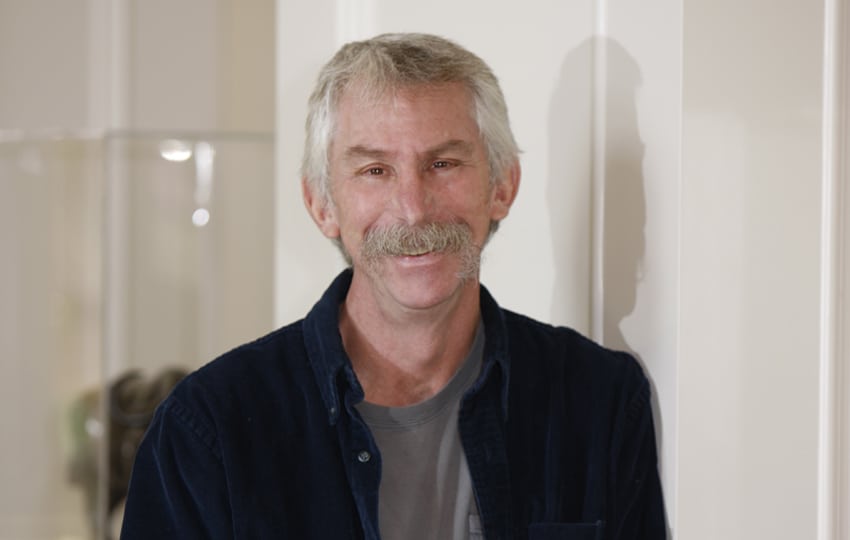David Zacharias

Associate Professor of Art
Scholarly Interest
“For years, I have had primarily one area of scholarly interest and that has been the making of ceramic vessels. Until this realization, I had worked with clay, producing sculptures and functional pieces. I had also sculpted in a wide variety of materials and had produced an impressive body of paintings on masonite. The realization to devote myself to making ceramic vessels evolved from immersing myself in the teaching of ceramics at Converse and the building and rebuilding of relationships with ceramists from all over the United States. The interaction with clay artists and students, some with aspirations of becoming clay artists, has fueled my passion for working in this unique material. Artists that I have had important relationships with are Ron Meyers, Robert Turner, William P. Daley and Don Reitz. Ron Meyers was my first ceramics professor at the University of South Carolina. At the Penland School of Crafts, I studied with Robert Turner. William P. Daley came to Converse to lead a 3-day workshop and I have participated at numerous workshops with Don Reitz.”
Intrigue of Discovery
The power of discovery is euphoric. It begins with an idea that is worthy of the time investment to see it through. Then the hard work takes place to take that idea from purely an idea or perhaps a series of sketches to an actual object. The height of this euphoria, for me, occurs when a piece is just completed in the damp clay state. At this time the clay is in what is called a leather hard state. I place the piece on a potters wheel, give it a slow spin and walk around the studio looking at it from various angles and distances. Sometimes minor changes will be made but it is at this time that the form and subtleties in the form are most bold. Although the end product is not realized until it comes out of the final firing, it is the leather hard state when the greatest discovery is made. Future exploration usually evolves from this state until an idea is exhausted.
Recent and Current Projects
After spending the better part of four years teaching myself to make large wheel-thrown jars, which culminated with a very ambitious sabbatical project, I have been led to making smaller vessels, ones that can be hand-held. When focusing so intently on large jars, my primary interest was the aesthetic impact of the outside of the forms. True, the interior form reflects the exterior form but the jars were not conducive to examining the interiors. With lids, exteriors were more apparent and interiors even less so. Many of the new small pieces are open forms such as bowls, plates and platters that confront the viewer first with the interior.
Inspiring Students
“There is a sort of formula to my method of inspiration. First, it is essential to learn the craft of handling any material. Some materials are easier to master than others but all materials require craft to manipulate. I define craft as ‘the attention one gives to what one does.’ This definition of craft is employed in almost all aspects of one’s life and is critical to working in clay. With clay, mastering the craft is often difficult, requiring great time and physical hardships. I do my best to encourage students to not get discouraged and to keep working. Like anything, the more time spent practicing, the greater the rewards. Its just that throwing on the potters wheel can seem to show almost no progress. The key is to accept this, not get defeated and to keep working. I regularly produce work in demonstration, explain what I have done and why and try to exhibit my work, hopefully setting an example worth following.”
Creativity & Discovery
“Creativity is where discovery begins. Creativity starts with an idea and is followed by a debate to determine the worthiness of the idea. If the idea is worthy of the hard work that follows, an end product may be realized. Once work begins, creativity does not stop but it rarely peaks again like it did when the idea was initially conceived. Creativity usually leads to something new or a new, better way or example of something that has already been done. Creativity is essential in almost everything that we do or involve ourselves with on a daily basis. The importance of creativity is immeasurable. Just as creativity is the essential spark that leads to the creation of almost all things, creativity has that same importance in our lives.”
Impact of Teaching
“I think a great deal of my success in the classroom depends on the work produced from semester to semester. This work and what I perceive to be student improvement is the clearest gauge, for me, of my impact in the classroom. On a larger scale, my impact can be measured by the successes of my students after graduation. Are they getting into graduate degree programs? Did they get jobs? Are they exhibiting their art? These are all clear gauges of success but may not be true indication of the impact of my teaching. When I have the students in a class and I witness their awareness of what makes their project successful, I know that my teaching has impacted favorably. When they know what they did and why they did it, both they and I know a greater sense of euphoria from the power of discovery.”